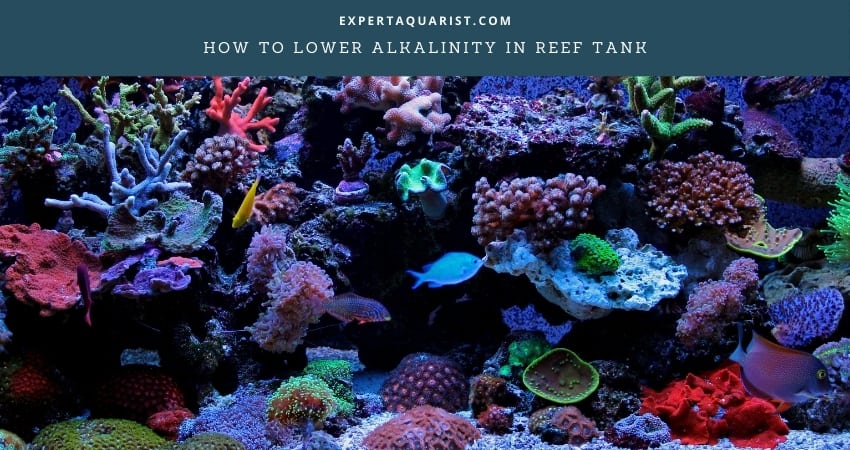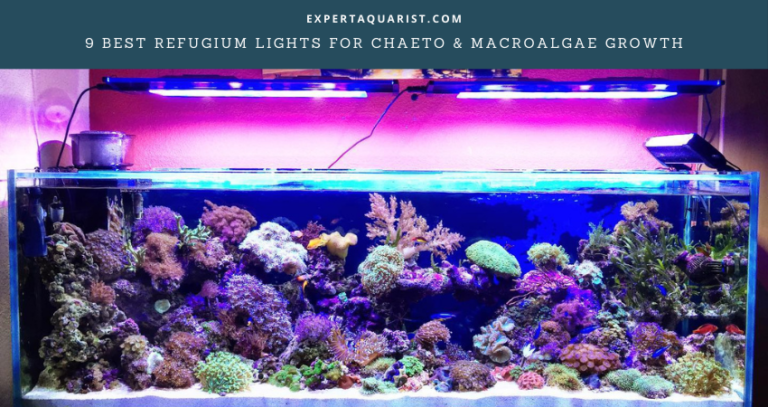Saltwater tanks or reef tanks are harder to take care of than their freshwater counterparts. One of the things that tank owners face the most problem with is keeping the alkalinity to a stable level. High levels of alkalinity can be very detrimental to the overall health of the fish and other organisms living in the tank.
There are quite a few ways you can bring the level of alkalinity down in your tank. From adding organic acids to just waiting it out, you can choose from a whole variety of methods of lowering alkalinity.
Let’s take a look at how to lower alkalinity in a reef tank and what the effects are of unstable alkalinity levels. We will also see how you can measure the alkalinity level yourself as well as other related topics which will help you down the line.
What do you mean by alkalinity?
Before going through the process of lowering the alkalinity in your reef tank, there are some basic things you should know about alkalinity.
The first thing you should know about alkalinity is what alkalinity itself is. It is the total of all the bases present in the tank. The main base found in the tank is carbonated. You can also find bicarbonates and hydroxides as well.

How can you lower alkalinity in reef tank?
There are quite a few ways you can bring the alkalinity level of your reef tank down. These methods will depend on the resources available to you and the kind of tank you possess.
1. Adding Organic acids
The best solution for high levels of alkalinity is to add some sort of organic acid, such as white vinegar. These acids will react with the bases present in the tank and neutralize them. This reaction is called a neutralization reaction.
But this reaction also causes the pH levels of the tank to go down. So it is better not to add white vinegar or other organic acids frequently.
If you do add too much white vinegar by mistake, stir the tank water. This will increase the oxygen levels of the tank which will, in turn, bring the level of pH to normal.
You can also move the outlets of the powerhead and face them towards the water.
2. Waiting it out
If you find out that your alkalinity levels are too high, no need to worry too much immediately. As alkalinity levels can spike in a flash, they can drop automatically as well. The corals in the tank will consume some of the alk and bring the alkalinity levels down over time. This time will vary based on the tank’s size and the number of corals present in the tank.
Corals can bring the alkalinity levels down by 1 or 2 dKH, which is a lot. One of the major advantages of this method is that the pH levels of your tank will remain the same.
3. Regularly changing the water
Another easy way to reduce alkalinity levels in your reef tank is to change a fourth or a fifth of your tank water per day. As the water introduced from outside has a greater chance of being of low dKH than the tank water, you can almost certainly bring the alkalinity levels down.
The ideal level of alkalinity
Another thing you must know about is the ideal alkalinity levels in a tank. There are two methods of measuring alkalinity levels in a tank. The first is mg/L (milligram per liter) or ppm (parts per million) method. But the method that is mostly used to measure alkalinity in a saltwater tank is the dKH (degree of carbonate hardness) method.
The ideal level of alkalinity in your saltwater tank is 8-12 dKH. Here, 1 dKH is equal to 17.9 mg/L or 17.9 ppm.
Read Next: Saltwater/Reef Tank Parameters
How do high levels of alkalinity affect the tank?
High levels of alkalinity can be extremely harmful to the life in your tank as well as the equipment present in it. Let’s discuss the topic further so that you have a better understanding.
A. Effect on corals
The corals in your tank will be harmed to a great deal by high levels of alkalinity. Diseases such as tissue loss and alkalinity burns have been noticed on corals that had been living in tanks having high alkalinity levels.
B. Effect on fish
If the high alkalinity levels persist in your tank, your fish will suffer from a whole host of diseases. The mucus layer of the fish gets damaged by high alkalinity. As a result, they become susceptible to various infections and bacterial diseases.
Another outcome of high alkalinity levels is the rise of ammonia levels. A high level of ammonia creates breathing problems for fishes and causes them to suffocate.
The growth of the fins and tails of the fish are hampered due to high alkalinity as well. Some fishes may even die due to prolonged periods of increased alkalinity.
C. Effect of equipment
Even the equipment you are using in the tank is not free from the danger of high levels of alkalinity. High alkalinity levels cause the calcium in the water to precipitate. This precipitated calcium coats the inner part of the equipment used in the tank such as the pump, the heater, and also the filter.
The calcium precipitation can also obstruct your view of the tank and also burn your pump out.
D. Effect on calcium levels
Calcium is an essential element for the growth of the fish and coral in the reef tank. But high alkalinity levels, as stated earlier, can cause precipitation of calcium in the tank. This creates a calcium deficiency in the water. This deficiency of calcium then stunts the growth of the organisms living in the tank.
How to Test Alkalinity levels
Before you go through any of the aforementioned methods of lowering alkalinity levels, first you should test the water. If you go in blindly, there is a chance that you will do more harm than good.
There are a couple of ways to test the level of alkalinity in your tank. They are :
A. Test Strips
The easiest way to test your tank water is to use test strips. The process of measuring the alkalinity will vary according to the manufacturers, but you can follow a basic way to do this.
First, dip the strip partly in the tank water. Keep it submerged for 10 seconds. This will allow the reagents in the strip to react with the water. After 10 seconds, you will notice a color in your strip which indicates the level of alkalinity in your tank.
Now compare that color to the reference in the container of the strips or the manual provided by the manufacturers. You may not obtain the exact colors given in the manual or container, in which case you just have to come to a conclusion using common sense.
B. Test kits
This is a more accurate method of determining the alkalinity levels in a reef tank. You can easily buy test kits from a retailer near you.
First, partially fill a test tube up with your tank water. Then mix the reagents that are provided with the kit with the water. Wait for a few minutes to allow the reagents to properly mix with the water in the tube. After they are completely mixed, the water in the test tube will take on a particular color. Then compare this color to the kit’s reference.
Although test kits provide more accurate results than test strips, you don’t always need to know the exact levels to treat your water.
The thing to remember while lowering alkalinity levels
There are a few things you should keep in mind when lowering your tank’s alkalinity levels.
- When going for any of the procedures to lower the level of alkalinity, it is better to be sure of the alkalinity. Without making sure that the tank’s alkalinity is indeed above 12 dKH, you run the risk of lowering the alkalinity levels below 8 dKH, which will be even more harmful to the tank and its inhabitants.
- If you use only one kit to test the water, there is a chance that it will give a wrong reading due to some malfunctions. So use two kits from two different companies. Although it will cost you more, it is better safe than sorry.
- While adding organic acids, initially start with a smaller dose.
- Don’t use any pH buffers in your tank while trying to lower the alkalinity levels. Because pH buffers cause a sudden upward spike in the alkalinity levels which will be counterproductive. So it is better to use other methods.
- If you see that the balance of calcium and alkalinity can not be achieved despite doing everything possible, try performing a magnesium test.
How to keep the balance between calcium and alkalinity
Both calcium and alkalinity levels are related to one another. The change in one of them affects the levels of another. So it is mandatory to make sure there is a balance between their levels.
- If both the calcium and alkalinity levels are high, it is better to keep applying both of them equally. Eventually, things will come to a normal level.
- On the other hand, for unusually low levels of calcium and alkalinity, add appropriate supplements equally. If this problem persists even after doing so, test the magnesium levels. Add magnesium if you find the levels to be below 1200 ppm.
- For excessive amounts of calcium, use alkalinity supplements. But do not use any calcium additives.
How to maintain the quality of water
To keep the alkalinity levels stable, you have to maintain the water quality. Here are some ways you can maintain the quality of your tank.
- Reduce the hardness of water to regulate the mineral levels. You can use RO to do this. But it is not recommended to use a tap water softener as it replaces magnesium and calcium with sodium. Elevated levels of sodium are extremely detrimental to the health of the inhabitants of reef tanks
- The temperature of the tank, pH levels, and alkalinity should be checked regularly. Also, ensure that the heater of the aquarium is properly working.
- Regularly test the nitrogen cycle with an ammonia kit.
- Always keep the tank clean. You can use things like freshwater and dilute vinegar for this purpose
Final thoughts
Everything in this world needs to be within a certain limit to keep the surroundings healthy. The alkalinity levels in a reef tank are no exception to this. Now that we have learned how to lower the alkalinity levels in a reef tank, it should be a piece of cake to keep the tank healthy. Just keep certain things in mind, and everything will go smoothly.






